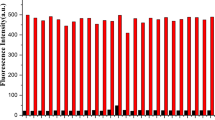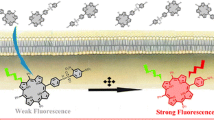Abstract
In this study, dicyanoisophorone was used as NIR (near-infrared spectroscopy) emission fluorophore, and thiobenzoate as the recognition function motif to fabricate probe HgS. Through the Hg-S linker, the whole molecule’s fluorescence was quenched due to the strong photoinduced electron transfer effect (PET). However, the Hg-S linker could be cut off upon the Hg2+ being added to the probe solution, leading to a strong fluorescence emission turned on by the intramolecular charge transfer effect (ICT). The probe HgS can respond to Hg2+ during the NIR emission spectral range and exhibits a significant Stokes shift (215 nm), excellent selectivity, and biocompatibility. Besides, the probe HgS can be used to monitor Hg2+ in bio-system and water samples.










Similar content being viewed by others
Data Availability
All information is included in the supplements.
References
Bera K, Das AK, Nag M, Basak S (2014) Development of a rhodamine–rhodanine-based fluorescent mercury sensor and its use to monitor real-time uptake and distribution of inorganic mercury in live zebrafish larvae. Anal Chem 86:2740–2746
Chen S-Y, Li Z, Li K, Yu X-Q (2021) Small molecular fluorescent probes for the detection of lead, cadmium, and mercury ions. Coord Chem Rev 429:213691
Ding G, Wu L, Feng H, Liu Y, Li J, Si H, Yao X, He M, He W (2020) The specific binding of a new 1,2,3-triazole to three blood proteins and its appended rhodamine complex for selective detection of Hg2+. Spectrochim Acta Part A Mol Biomol Spectrosc 228:117728
Erdemir S, Malkondu S (2022) A switch-on xanthene-triphenylamine-based fluorescent and a colorimetric sensor for the detection of ultra-trace Hg2+ in food samples and living cells. Food Chem 376:131951
Leopold K, Foulkes M, Worsfold PJ (2009) Preconcentration techniques for the determination of mercury species in natural waters. TrAC, Trends Anal Chem 28:426–435
Shu W, Yan L, Liu J, Wang Z, Zhang S, Tang C, Liu C, Zhu B, Du B (2015) Highly selective fluorescent probe for the sensitive detection of inorganic and organic mercury species assisted by H2O2. Ind Eng Chem Res 54:8056–8062
Shu W, Wang Y, Wu L, Wang Z, Duan Q, Gao Y, Liu C, Zhu B, Yan L (2016) Novel carbonothioate-based colorimetric and fluorescent probe for selective detection of mercury ions. Ind Eng Chem Res 55:8713–8718
Tian M, Liu L, Li Y, Hu R, Liu T, Liu H, Wang S, Li Y (2014) An unusual OFF–ON fluorescence sensor for detecting mercury ions in aqueous media and living cells. Chem Commun 50:2055–2057
Wu X, Li Y, Yang S, Tian H, Sun B (2020) A multiple-detection-point fluorescent probe for the rapid detection of mercury(II), hydrazine and hydrogen sulfide. Dyes Pigm 174:108056
Yuan B, Wang D-X, Zhu L-N, Lan Y-L, Cheng M, Zhang L-M, Chu J-Q, Li X-Z, Kong D-M (2019) Dinuclear HgII tetracarbene complex-triggered aggregation-induced emission for rapid and selective sensing of Hg2+ and organomercury species. Chem Sci 10:4220–4226
Zhang Y, Ma D (2021) Selective detection of peroxynitrite in living cells by a near-infrared diphenyl phosphinate-based dicyanoisophorone probe. Spectrochim Acta Part A Mol Biomol Spectrosc 244:118890
Zhang Y, Yuan B, Ma D (2020) Selective recognition of Zn(II) ions in live cells based on chelation enhanced near-infrared fluorescent probe. Inorg Chim Acta 508:119640
Zhang Y, Arachchige DL, Olowolagba A, Luck RL, Liu H (2022a) Near-infrared fluorescent probe based on rhodamine derivative for detection of NADH in live cells. Methods 204:22–28
Zhang Y, Qiu X, Sun L, Yan Q, Luck RL, Liu H (2022b) A two-photon fluorogenic probe based on a coumarin Schiff base for formaldehyde detection in living cells. Spectrochim Acta Part A Mol Biomol Spectrosc 274:121074
Funding
This work was supported by grants from the National Natural Science Foundation of China (Grant Nos. 22106008).
Author information
Authors and Affiliations
Contributions
Yibin Zhang: conceptualization, investigation, funding acquisition. Qing Yana, Yueting Cheng, Boling Wang, Xiaoqian Rong, Yanhong Kuang, Xianyu Qiu, Lin Sun: investigation. Yanyan Zhou: methodology, writing–reviewing and editing.
Corresponding authors
Ethics declarations
Competing interests
The authors declare no competing interests.
Conflict of Interest
Yibin Zhang declares that he has no conflict of interest. Qing Yana declares that he has no conflict of interest. Yueting Cheng declares that he has no conflict of interest. Boling Wang declares that he has no conflict of interest. Xiaoqian Rong declares that he has no conflict of interest. Yanhong Kuang declares that he has no conflict of interest. Xianyu Qiu declares that he has no conflict of interest. Lin Sun declares that he has no conflict of interest. Yanyan Zhou declares that he has no conflict of interest.
Additional information
Publisher's Note
Springer Nature remains neutral with regard to jurisdictional claims in published maps and institutional affiliations.
Supplementary Information
Below is the link to the electronic supplementary material.
Rights and permissions
Springer Nature or its licensor holds exclusive rights to this article under a publishing agreement with the author(s) or other rightsholder(s); author self-archiving of the accepted manuscript version of this article is solely governed by the terms of such publishing agreement and applicable law.
About this article
Cite this article
Zhang, Y., Yan, Q., Cheng, Y. et al. A Novel “Off–On” NIR Fluorescent Probe for Detecting Hg2+ Based on Dicyanoisophorone and Its Application in Bio-imaging and Real Water Samples. Food Anal. Methods 15, 3490–3497 (2022). https://doi.org/10.1007/s12161-022-02377-1
Received:
Accepted:
Published:
Issue Date:
DOI: https://doi.org/10.1007/s12161-022-02377-1




